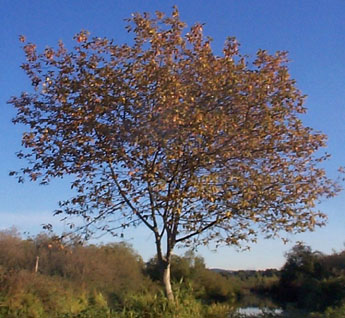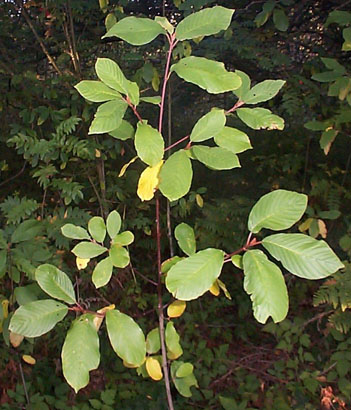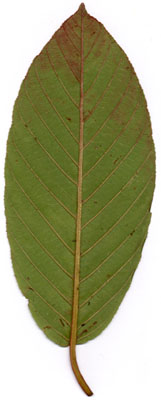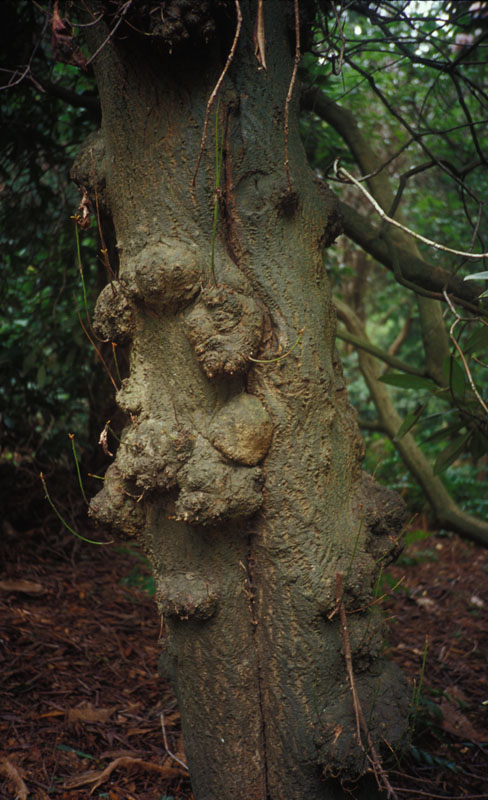Plant of the Month: October 2002
|
| Cascara |
| Rhamnus Purshiana DC. |
= Frangula Purshiana (DC.) Cooper
|
RHAMNACEÆ; Buckthorn Family
|
| Cascara is an unglamorous, uncommon little tree native from British Columbia to Montana and California. But no Pacific
Northwest tree has had a longer and more vital role in medicine. |
| In dry sunny sites cascara can be merely shrubby. It has smooth gray bark,
recalling that of Tree of Heaven (Ailanthus altissima). Minuscule greenish flowers bloom from late April into early June, but mostly in May.
These attract various insects, then give rise to berries, first green, then purplish, finally black, soft and shiny. From August into October it ripens the half-inch
wide berries, each with 2 or 3 big seeds. The berries taste like coffee, and are eaten not only by birds but bears, raccoons, foxes, deer, and so
on. |
| The leaves, commonly measuring 4 inches long by 1 and a half-inches wide, can be as large as 8 x 3 inches; they are distinctive with
10 - 17 pairs of neatly parallel veins, unlike those of most trees. Cascara only asserts itself --relatively-- when its leaves turn color in
autumn. In the woods, fall color is pure yellow; in open areas, hints of orange, red, purple, and green commingle. Saplings in the woods
stay evergreen. Unlike most trees, cascara's winter buds are
naked, not covered by scales. But they are well protected by brown fuzzy hairs.
If you look closely at cascara stems and leaves you will see close fine brownish hairs. |
| Since the tree is short-lived, large old examples are scarce. To find one more than 60 years old is difficult. To locate one 60 feet tall
is a triumph; trunks 12 inches thick are rare. The tallest ever recorded was 70 feet, and the thickest trunk 3 feet. Its wood is yellowish
and weighs 31 to 37 pounds per cubic foot. It has been largely unused by humans, being mostly burnt as firewood. But some people
have fashioned furniture from it, and country folk found it serviceable for fenceposts, spokes, handles, and so on. |
| Other names include cascara buckthorn, cáscara sagrada ("holy bark" in Spanish), sacred bark tree, Oregon bearwood,
bitterbark, coffeetree, coffeeberry, shittimwood, chittam, chittim, and buckthorn. |
| Native Americans showed early Spanish explorers how cascara's bark helped when used as a tonic and laxative. By 1878 it
was marketed commercially. It still is. Millions of pounds of the bark is harvested annually from wild trees, then is dried for a year
(otherwise it is too potent and harsh), and finally is used to make a fluid extract, or can be directly made into a tea. It tastes horribly bitter but
works gently and efficiently. Over 100 years ago, a New Orleans medical doctor accidentally discovered that cascara is an arthritis remedy
of rare efficacy. While routinely treating some arthritic patients for constipation, the doctor was startled to find their arthritic
pains decreased markedly. Cascara has also been used to treat eczema. And Julia F. Morton writes in
Herbs and Spices (1976) that "The extract, with the bitterness removed, is a common flavoring for soft drinks, baked goods, and ice cream." |
| Cascara has been planted seldom as an ornamental tree, because of its short lifespan and plain appearance. But it is valuable for
native plant gardens and to attract wildlife. Seedlings can be bought from nurseries that are well-stocked with Pacific Northwest native
plants. In the Seattle area, Colvos Creek Nursery (on Vashon Island) has plenty of $7.00 one-gallon sizes, as well as
Rhamnus Alaternus, Rhamnus
californica, Rhamnus crocea, Rhamnus
Frangula, and Rhamnus tomentella. Colvos Creek Nursery, P.O. Box 1512, Vashon Island, WA
98070. Telephone: (206) 749-9508. Website: (www.colvoscreeknursery.com). E-mail: mlla@mindspring.com |
The generic name Rhamnus is derived from an ancient Greek name of a spiny shrub:
rhamnos. The specific name Purshiana was given in 1825 to commemorate Frederick Traugott Pursh (1774 - 1820), the U.S. botanist who first described this species scientifically
in 1814 in Flora America Septentrionalis. Nine species of
Rhamnus are native to North America. Two Eurasian species are naturalized
weedily in places here: Rhamnus cathartica L. (common buckthorn) and
Rhamnus Frangula L. (alder buckthorn). Some botanists prefer to break
the genus Rhamnus into two genera: Frangula and Rhamnus. But historically most botanists have united these as subgenera under
the Rhamnus lead, constituting a widespread genus of between 125 and 160 species.
Back
|

Rhamnus fall color photo by Emenke
|

Rhamnus leaf photo by Emenke
|

Rhamnus leaf scan by ALJ
|

Rhamnus trunk photo by ALJ
|
|
|

